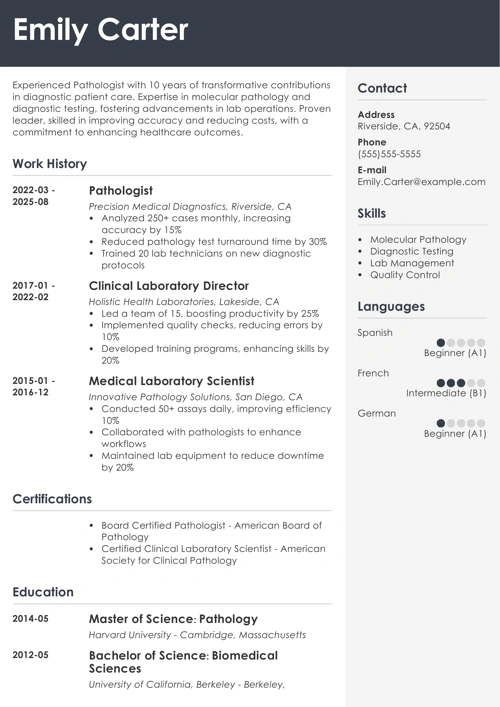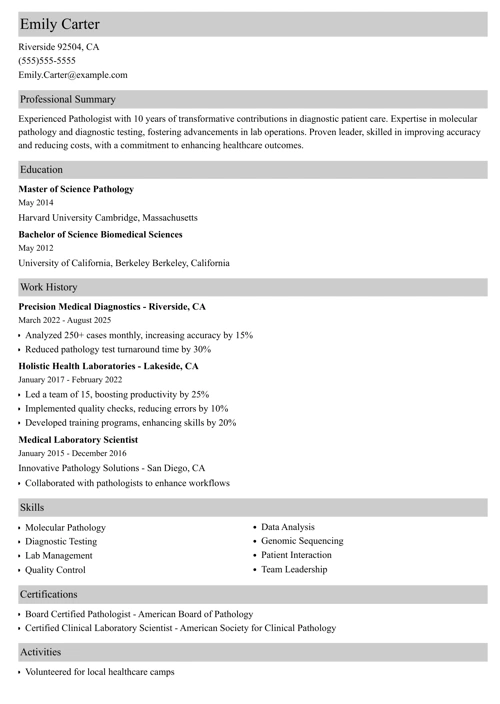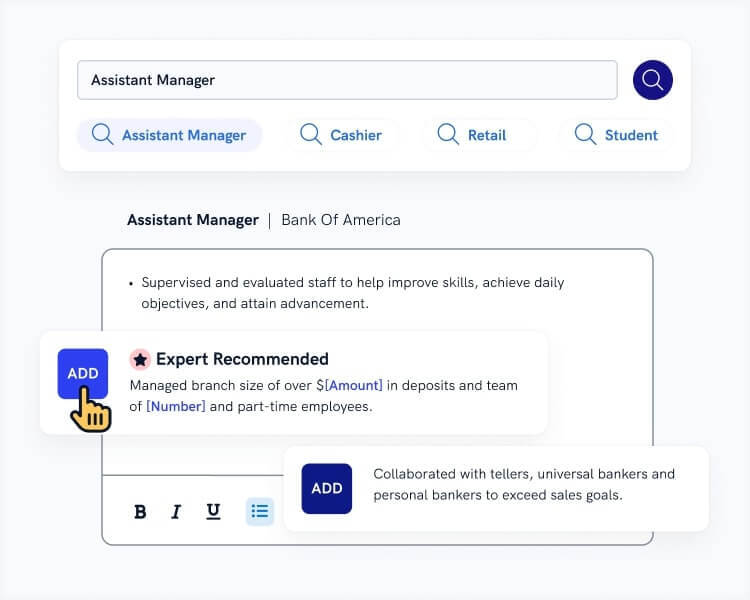Are you eager to step into the fascinating realm of pathology and make a pathologist resume that truly reflects your proficiency? Although drafting a resume for the medical sector can seem daunting, there's no need to fret! This article provides expert advice, comprehensive pathologist resume examples, and creative techniques to present your skills effectively. Let’s begin!
This guide will show you:
- A pathologist resume example better than 9 out of 10 other resumes.
- How to build a pathologist resume that will increase your chances of getting interviews.
- Tips and examples for emphasizing skills and achievements on a pathologist resume.
- How to describe your experience on a resume for a pathologist to secure any job you desire.
Want to save time and have your resume ready in 5 minutes? Try our resume builder. It’s fast and easy to use. Plus, you’ll get ready-made content to add with one click. See 20+ resume templates and create your resume here.
Sample resume made with our builder—See more resume examples here.
Curious about more resume examples? Take a look here:
- Medical Doctor Resume Example & Writing Guide
- Physician CV Example & Writing Guide
- Healthcare Professional Resume Example & Writing Guide
- Medical Resume Example & Writing Guide
- Physician Assistant Resume Example & Writing Guide
- Lab Technician Resume Example & Writing Guide
- Medical Resident CV Example & Writing Guide
- Clinical Research Coordinator Resume Example & Writing Guide
- Public Health Resume Example & Writing Guide
- Academic CV Example & Writing Guide
- Resume Examples & Writing Guides for All Jobs
Pathologist Resume Example
Dr. Emily Carter, MD, FCAP
Pathologist
(555) 987-6543
emily.carter@email.com
linkedin.com/in/dr-emily-carter
Summary
Board-certified Pathologist with 10+ years of experience in anatomic and clinical pathology, specializing in disease diagnosis, laboratory medicine, and forensic pathology. Skilled in histopathology, molecular diagnostics, and laboratory management. Committed to advancing patient care through accurate and timely pathological analysis. Eager to contribute expertise in disease diagnosis and research at Johns Hopkins Medical Center.
Experience
Pathologist
Northwest Medical Laboratory, Seattle, WA
July 2014–February 2025
Key Qualifications & Responsibilities
- Conducted anatomic and clinical pathology examinations, diagnosing diseases through microscopic and molecular analysis.
- Analyzed biopsy and autopsy samples to identify cancerous and infectious diseases, ensuring accurate reporting for treatment decisions.
- Led a team of laboratory professionals, overseeing quality control and adherence to medical regulations.
- Provided expert consultation to clinicians, oncologists, and surgeons on pathology findings to guide patient care.
Key Achievement:
- Introduced a digital pathology system that improved diagnostic efficiency by 25% and enhanced collaboration with remote specialists.
Forensic Pathology Fellow
State Medical Examiner’s Office, San Francisco, CA
July 2012–June 2014
Key Qualifications & Responsibilities
- Performed autopsies to determine causes of death in forensic cases, compiling detailed pathology reports.
- Worked closely with law enforcement and legal professionals, presenting findings in court as an expert witness.
- Assisted in research projects on disease pathology and post-mortem toxicology.
Key Achievement:
- Published a peer-reviewed study on forensic toxicology findings in unexplained deaths, influencing national investigative protocols.
Education
Doctor of Medicine (MD)
Harvard Medical School, Boston, MA
September 2006–June 2010
Bachelor of Science in Biology
University of California, Los Angeles (UCLA), Los Angeles, CA
September 2002–May 2006
Skills
- Anatomic & Clinical Pathology
- Histopathology & Cytopathology
- Molecular Diagnostics & Genetic Testing
- Forensic Pathology & Autopsies
- Cancer Diagnosis & Staging
- Laboratory Operations & Quality Control
- Digital Pathology & Image Analysis
- Expert Witness Testimony
Certifications and Licenses
- Board Certified in Anatomic & Clinical Pathology, American Board of Pathology, 2015
- Fellow, College of American Pathologists (FCAP), 2017
- Medical License: State of Washington, License No. MD123456
- Advanced Cardiovascular Life Support (ACLS), American Heart Association, current
Languages
- English—Native
- Spanish—Conversational
Awards
- 2020, Excellence in Pathology Award, American Society for Clinical Pathology
Memberships
Member of the American Society for Clinical Pathology since 2010
- Presented research findings at the 2021 ASCP Annual Meeting
- Contributed to the development of new pathology guidelines
Interests
- Volunteering at local health fairs to provide free diagnostic services
- Writing articles on medical advancements for a pathology-focused blog
Here’s how to write your own pathologist resume:
1. Format Your Pathologist Resume Correctly
Creating a remarkable pathologist resume presents its own set of challenges. With numerous candidates vying for each medical position, your resume must capture attention quickly. What will make it stand out? A well-structured resume format that exudes professionalism can be your key to success.
To format your pathologist resume effectively:
- Start with a resume header. Include your name, phone number, email, LinkedIn profile, and a link to your online portfolio. These are the essential contact details for a resume.
- While your street address is optional, include your city if it aligns with the job location.
- Develop a reverse-chronological resume. This resume type starts with your most recent position and is the preferred layout for resumes by employers.
- Opt for a professional font like Calibri or Arial. The ideal font size for resumes is between 10 and 12 points.
- Name your resume file as “Your Name - Pathologist - Resume.pdf” A PDF resume format is preferred over MS Word because it maintains the layout.
- The best resume length for entry-level pathologists is one page. Those with significant accomplishments might extend to a two-page resume or more.
Master the art of resume creation with these essential tips: How to Make a Resume
2. Customize Your Pathologist Job Description
Why is it crucial to customize your resume for each job? Because generic resume experience sections don’t lead to interviews. If a hiring manager sees a list of pathologist tasks, they might think, “Okay, this person was a pathologist. But how competent were they?”
Here’s how to add pertinent experience to your resume:
- Use the exact job title mentioned in the job posting. ATS resumes perform better with precise position titles.
- After listing the company name and your employment dates, include 3–6 bullet points. (More for recent roles, fewer for older ones.)
- Demonstrate your use of relevant skills by showcasing numerous accomplishments. The best achievements on a resume are quantifiable and highlight KPIs.
- Initiate sentences with resume action verbs such as coordinated, designed, and prepared.
Pathologist Resume Examples: Responsibilities
- Analyze and interpret complex laboratory data to diagnose diseases.
- Conduct autopsies to determine the cause of death and gather medical evidence.
- Collaborate with medical professionals to provide accurate diagnostic information.
- Develop and implement laboratory protocols and safety guidelines.
- Oversee quality control processes to ensure the accuracy of test results.
- Educate medical staff and students on pathology findings and procedures.
- Engage in research to advance understanding of disease mechanisms.
Remember to use action verbs that convey your responsibilities and achievements effectively. Here are some action verbs for pathologist resumes:
Pathologist Resume Examples: Action Verbs
- Led
- Coordinated
- Analyzed
- Diagnosed
- Interpreted
- Examined
- Conducted
- Supervised
- Developed
- Optimized
- Collaborated
- Researched
Effectively articulate your current job responsibilities: Describe Your Current Job Responsibilities
3. Make Your Education Section Count
Everyone lists their educational background on a resume. But if you stop at the degree title, university name, and dates, you’re missing the point. That’s like having an advanced tool and just using it for simple tasks. If you leverage your education to demonstrate added skills, you’ll see your interview count rise.
See these resume tips:
- The best resume degree placement is right after your work history.
- In an entry-level pathologist resume, add relevant classes to help prove your skills.
- In a resume with experience, you can still add bullet points if you received a fellowship, scholarship, or held a leadership post.
- Should you write your GPA in a resume? If it’s scraping the ionosphere, do it.
Find empowering job opportunities for people with disabilities that leverage unique strengths: Jobs for People with Disabilities
Creating a resume with our builder is incredibly simple. Follow our step-by-step guide and use content from Certified Professional Resume Writers to have a resume ready in minutes.
When you’re done, Zety’s resume builder will score your resume and our resume checker will tell you exactly how to make it better.
4. Prove the Pathologist Resume Skills the Company Wants
When it comes to showcasing skills on a resume, it's essential to do it strategically. You know you need to highlight 5–10 key skills relevant to pathology, but randomly choosing them can be detrimental. Instead, focus on the most crucial abilities mentioned in the job listing.
Here's how to incorporate pathologist skills into your resume:
- The skills mentioned in the job advertisement are essential resume keywords. Integrate them into your resume’s skill list.
- Avoid overloading your resume with too many skills (like 20). Too many can dilute the impact of the ones that matter most to employers.
- To maximize your interview opportunities, ensure the skills in your list are also reflected in your job duties and education achievements.
Here are some hard and soft skills for a resume relevant to pathologists:
Pathologist Resume Skills
- Laboratory Diagnostic Techniques
- Disease Pathology Analysis
- Autopsy Procedures
- Medical Research
- Laboratory Protocol Development
- Quality Control Oversight
- Clinical Pathology
- Interpersonal Skills
- Verbal and Written Communication Skills
- Leadership Skills
- Organizational Skills
- Active Listening
- Problem-Solving Skills
- Time Management Skills
- Attention to Detail
- Stress Management
- Teamwork Skills
- Computer Skills
- Adaptability
Unleash your leadership potential by learning how to highlight these skills on your resume: How to Showcase Your Leadership Skills
5. Add Other Sections to Your Pathologist Resume
To showcase your potential as a valuable team member, it's important to highlight your unique attributes. Here are additional sections you can add to your pathologist resume to demonstrate your capabilities:
- Include any certifications relevant to pathology, such as board certifications or specialized training.
- If you've published research papers or articles in medical journals, list these publications in your resume to establish your expertise.
- Membership in professional associations demonstrates engagement in the field. Highlight any affiliations you have.
- Volunteer work related to healthcare or pathology can be a great addition. Find out where to include volunteer work on your resume for maximum impact.
- Language skills can be a significant asset. Learn how to present language skills on your resume effectively.
6. Write a Pathologist Resume Summary or Resume Objective
To immediately grab a recruiter's attention, it's crucial to create an engaging resume introduction. According to our HR statistics report, recruiters typically spend only a few seconds scanning through resumes. Use this brief opportunity to make your resume stand out.
We refer to this as a resume profile. Some might liken it to an elevator pitch, but while an elevator pitch takes 30 seconds, your resume profile should make an impact in just one paragraph.
If you've worked in the field for over a year, mention your experience, job title, and how you can benefit the company, and include a couple of notable achievements. This is known as a resume professional summary, and it should be placed prominently at the top.
But what if you're creating a resume with no experience? The approach is similar, but instead, you draw attention to your academic successes or personal projects. This version is referred to as the objectives for a resume.
Uncover the secrets to crafting a standout resume with a compelling Summary of Qualifications that catches recruiters' eyes.
7. Write a Cover Letter for Your Pathologist Resume
Are cover letters necessary in 2025? More than ever. Too many applicants these days send the same, generic resumes at every job opening. It’s refreshing to see a resume come in that looks like the candidate cares about the job. A cover letter proves that you’re interested in this company in particular.
Create your resume cover sheet like this:
- Use a professional cover letter structure: with the same header as your resume and a business-ready signoff at the end.
- How to format cover letter: 3–5 paragraphs and less than a full page.
- How to begin a cover letter: job title in the first sentence and an icebreaker that makes them continue reading.
- Middle paragraphs: include a few of your achievements.
- How to end it: write a cover letter conclusion that adds a few more skills and requests a conversation to discuss how you can help them.
- Finally, write an application follow-up email weekly for a month. Make it super short, and attach your resume and cover letter in PDFs.
Streamline your job application process with this cover letter template for Word: Cover Letter Template Word
Plus, a great cover letter that matches your resume will give you an advantage over other candidates. You can write it in our cover letter builder here. Here's what it may look like:
See more cover letter templates and start writing.
Your pathologist resume is a vital step toward the career you've been dreaming of, so give it the attention it deserves. Remember, the goal is to showcase your expertise and passion effectively. I wish you success in your job search journey!
About Zety’s Editorial Process
This article has been reviewed by our editorial team to make sure it follows Zety's editorial guidelines. We’re committed to sharing our expertise and giving you trustworthy career advice tailored to your needs. High-quality content is what brings over 40 million readers to our site every year. But we don't stop there. Our team conducts original research to understand the job market better, and we pride ourselves on being quoted by top universities and prime media outlets from around the world.




